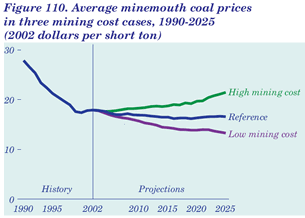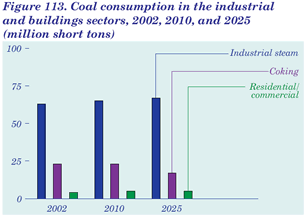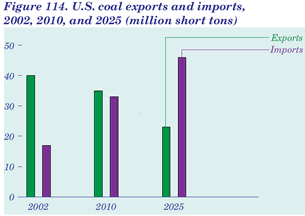|
Annual Energy Outlook 2004 with Projections to 2025 Market Trends - Coal Index (click to jump links) Emissions Caps Lead to More Use of Low-Sulfur Coal From Western Mines Continued improvements in mine productivity (which have averaged 5.9 percent per year since 1980) are projected to cause falling real minemouth prices throughout the forecast relative to historical levels. Higher electricity demand and lower prices, in turn, are projected to yield increasing coal demand, but the demand is subject to the overall sulfur emissions cap in the Clean Air Act Amendments of 1990, which encourages progressively greater reliance on the lowest sulfur coals (from Wyoming, Montana, Colorado, and Utah).
The use of western coals can result in up to 85 percent lower sulfur dioxide emissions than the use of many types of higher sulfur eastern coals. As coal demand grows over the forecast, however, new coal-fired generating capacity is required to use the best available control technology (scrubbers or advanced coal technologies), which can reduce sulfur emissions by 90 percent or more, providing market opportunities for higher sulfur coal throughout the forecast. From 2002 to 2025, production of high- and medium-sulfur coal is projected to increase from 578 to 664 million tons (0.6 percent per year), and low-sulfur coal production is projected to rise from 527 to 879 million tons (2.2 percent per year). As a result of the competition between low-sulfur coal and post-combustion sulfur removal, western coal production is expected to continue to increase, but its projected annual growth rate falls from 8.4 percent, achieved between 1970 and 2002, to 2.2 percent in the forecast period. Western coal production is projected to rise from 601 million tons in 2002 to 706 million tons in 2010 and 996 million tons in 2025 (Figure 106). Rate of Decline in Minemouth Coal Price Is Expected To Slow The average minemouth coal price, which fell by 3.6 percent per year (in constant dollars) from 1990 to 2002, is projected to continue declining, from $17.90 in 2002 to $16.19 per ton in 2016 (2002 dollars), as mine productivity rises and lower cost production in the West increases. Average minemouth prices trend upward after 2016, as productivity improvements slow and increasing coal demand creates a need for new coal-mining capacity. In 2025, the average minemouth price is projected to remain lower than the real price in 2002 at $16.57 per ton (Figure 107). The mines of the Northern Great Plains, with thick seams and low overburden ratios, have had higher labor productivity than other coalfields, and their advantage is expected to be maintained throughout the forecast. Average U.S. coal mining labor productivity (Figure 108) is projected to follow the trend for eastern mines most closely, because eastern mining is more labor-intensive than western mining. Coal Mining Labor Productivity Coal Mine Employment Is Expected To Remain Near Current Levels Gains in coal mine labor productivity result from technology improvements, economies of scale, and better mine design. At the national level, average labor productivity is also expected to be influenced by changing regional production shares. Competition from low-sulfur, low-cost western and imported coals is projected to limit the growth of eastern low-sulfur coal mining. The boiler performance of western low-sulfur coal has been tested successfully by many electricity generators, and its use in eastern markets is projected to increase. Eastern coalfields contain extensive reserves of higher sulfur coal in moderately thick seams suited to longwall mining. Continued penetration of technologies for extracting and hauling large volumes of coal in both surface and underground mining suggests that further reductions in mining cost are likely. Improvements in labor productivity have been, and are expected to remain, the key to lower coal-mining costs. As labor productivity improved from 1970 to 2002, the average number of miners working daily fell by 2.0 percent per year. Over the forecast period, substantial increases in coal production, coupled with the expectation that productivity improvements will be considerably less than during the past 20 years, result in a stable outlook for employment in the coal industry (Figure 109). The average number of employees working at U.S. coal mines is projected to increase from 75,000 in 2002 to 79,000 in 2025. Lower Mining Cost Assumptions Lead to More Coal Consumption Alternative assumptions about future mining costs affect projected coal prices and the choice of fuels for electricity generation. In two alternative mining cost cases, minemouth prices, delivered prices, and the resulting fuel consumption patterns in the electricity sector vary with changes in projected mining costs. Productivity is assumed to increase by 1.3 percent per year through 2025 in the reference case, while wage rates and equipment costs are constant in 2002 dollars. The national average minemouth coal price is projected to decline by 0.3 percent per year to $16.57 per ton in 2025 (Figure 110). In the low mining cost case, productivity is assumed to increase by 2.9 percent per year, and real wages and equipment costs are assumed to decline by 0.5 percent per year [118]. As a result, the average minemouth price falls by 1.3 percent per year to $13.27 per ton in 2025, 20 percent less than projected in the reference case. Projected U.S. coal consumption is 44 million tons (2.8 percent) higher in the low mining cost case than in the reference case in 2025, primarily as a result of switching to coal from natural gas in the electricity sector when gas prices rise later in the forecast. The high mining cost case assumes that productivity declines by 0.6 percent per year and real wages and equipment costs increase by 0.5 percent per year. Consequently, the average minemouth price of coal is projected to increase by 0.8 percent per year, to $21.45 per ton in 2025, 29 percent higher than in the reference case. Coal consumption in 2025 is 142 million tons (9.1 percent) lower in the high mining cost case than in the reference case, because less coal-fired capacity is projected to be added. Coal Consumption for Electricity Continues To Rise in the Forecast Domestic coal demand is projected to increase by 501 million tons in the reference case forecast, from 1,066 million tons in 2002 to 1,567 million tons in 2025 (Figure 111), because of projected growth in coal use for electricity generation. Total coal demand in other end-use sectors is projected to remain relatively constant. Coal consumption for electricity generation is projected
to increase from 976 million tons in 2002 to 1,477 million tons
in 2025 as the utilization of existing coal-fired generation capacity
increases and, in later Low-Sulfur Coal Continues To Gain Share in the Generation Market Phase 1 of CAAA90 required 261 coal-fired generating units to reduce sulfur dioxide emissions to about 2.5 pounds per million Btu of fuel. Phase 2, which took effect on January 1, 2000, tightened the annual emissions limits imposed on large, higher emitting plants and also set restrictions on smaller, cleaner plants fired with coal, oil, and gas [119]. During Phase 1, many generators switched either partially or entirely from higher sulfur bituminous to low-sulfur subbituminous coal, incurring relatively modest capital investments. Such fuel switching often generated sulfur dioxide allowances beyond those needed for Phase 1 compliance, and the excess allowances generated during Phase 1 were banked for use in Phase 2 or sold to other generators. In the forecast, fuel switching for regulatory compliance and for cost savings is projected to reduce the composite sulfur content of all coal produced (Figure 112). The main sources of low-sulfur coal are the Central Appalachian, Powder River Basin, and Rocky Mountain regions and coal imported from Colombia, Venezuela, and Indonesia. Coal users could face additional costs in the future if additional or new restrictions on emissions are adopted. An example of a proposal to further reduce emissions from U.S. power plants is the Bush Administration’s Clear Skies Initiative. Relative to current law and regulations, the Administration’s proposal specifies further restrictions on emissions of nitrogen oxides and sulfur dioxide and would introduce a national cap on mercury emissions. Industrial Steam Coal Use Rises, But Demand for Coking Coal Declines For applications other than electricity generation, a projected increase of 4 million tons in industrial steam coal consumption between 2002 and 2025 (0.3-percent annual growth) is expected to be more than offset by a decrease of 5 million tons in coking coal consumption (Figure 113). Increasing consumption of industrial steam coal is projected to result primarily from greater use of existing coal-fired boilers in energy-intensive industries. The projected decline in domestic consumption of coking coal results from the expected displacement of raw steel production from integrated steel mills (which use coal coke for energy and as a material input) by increased production from minimills (which use electric arc furnaces that require no coal coke) and by increased imports of semi-finished steels. The amount of coke required per ton of pig iron produced is also declining, as process efficiency improves and injection of pulverized steam coal is used increasingly in blast furnaces. Domestic consumption of coking coal is projected to fall by 1.2 percent per year from 2002 to 2025. Although total energy consumption in the combined residential and commercial sectors is projected to grow by 1.3 percent per year, most of the growth is expected to be captured by electricity and natural gas. Coal consumption in the residential and commercial sectors is projected to remain constant, accounting for less than 1 percent of total U.S. coal demand in the forecast. Declining U.S. Coal Exports, Rising Imports Are Projected U.S. coal exports declined sharply from 1998 to 2002, from 78 million tons to 40 million tons, and are projected to continue declining in the reference case to 23 million tons in 2025 (Figure 114). Recent declines in U.S. coal exports occurred against the backdrop of a world coal market that saw an increase in trade from 546 million tons in 1998 to 656 million tons in 2002. While low-cost supplies from China, Indonesia, Russia, and Australia satisfied much of the growth in international steam coal demand, low-cost supplies of coking coal from Australia supplanted substantial amounts of U.S. coking coal in the world market. The U.S. share of total world coal trade is projected to fall from 6 percent in 2002 to less than 3 percent in 2025, as international competition intensifies and coal imports to Europe and the Americas grow more slowly or decline. From 2002 to 2025, U.S. steam coal exports are projected to drop from 19 million tons to 10 million tons, despite substantial projected growth in world steam coal trade. U.S. coking coal exports are also projected to decline, from 21 million tons in 2002 to 13 million tons in 2025, while a small increase in the world trade in coking coal is expected. U.S. imports of low-sulfur coal are projected to grow from 17 million tons in 2002 to 46 million tons in 2025. For many coastal power plants, imports will be the least costly option for meeting emissions targets. The addition and expansion of existing coal import facilities in the United States, along with a reduction in demand for coal in Europe, are likely to contribute to projected increases in coal imports. Much of the low-sulfur coal projected to be imported is expected to come from Colombia, Venezuela, and Indonesia.
Released: January 2004 |








